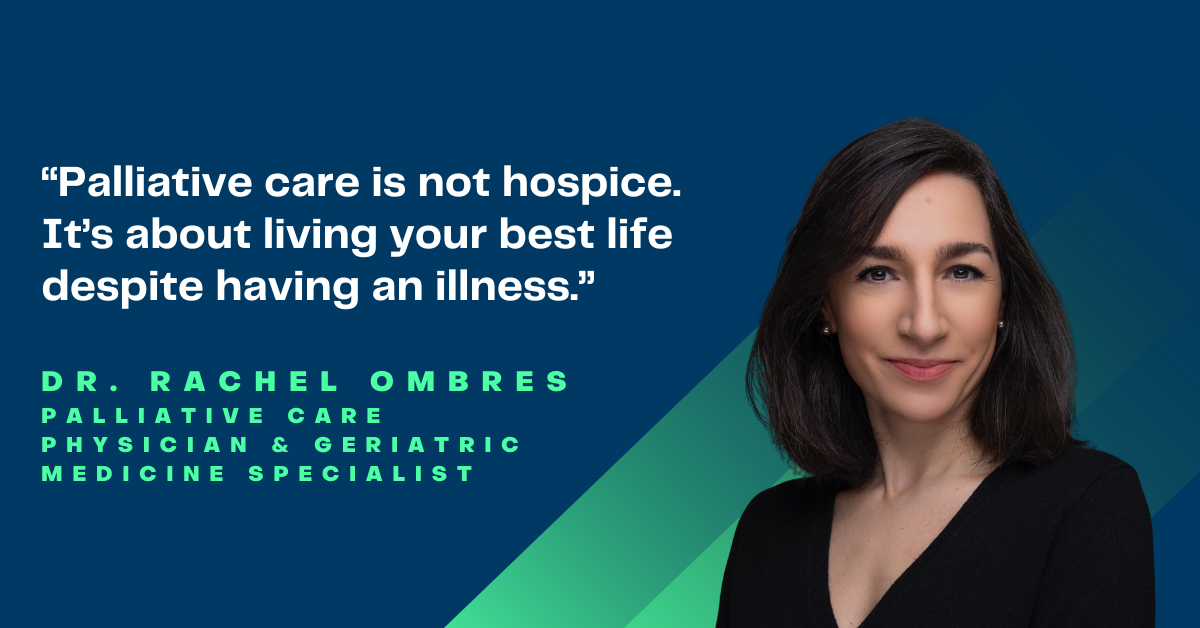Rachel Ombres, MD, started practicing geriatric and palliative care medicine after witnessing a gap in the way health care was delivered to patients experiencing life with serious illness. “It often seemed that nobody was taking responsibility for alleviating the suffering,” she says.
Now, as a palliative care physician and geriatric medicine specialist working with Enhanced Community Care Management (ECCM), she helps improve the quality of life for patients and their families.
“It’s important to understand that palliative care is not hospice. It’s learning how to live your best life despite having an illness,” she says.
Dr. Ombres shares how ECCM’s interdisciplinary team provides person-centered, family-centered care to help patients with complex health conditions maintain independence.

Catherine Clements: Dr. Ombres, let’s start with a bit about your professional background. What made you interested in palliative care?
Dr. Rachel Ombres: When I first started my medical training, palliative care was just becoming a specialty — and I immediately jumped on board. A few years into my practice, I saw the huge impact geriatricians and palliative care providers can make for one patient and one family. That was meaningful to me, but the next step I wanted for my career, and for health care at large, would be taking this approach to the population health level, which is what ECCM is doing.
Catherine Clements: What’s different about ECCM’s approach compared to other palliative care programs?
Dr. Rachel Ombres: What sets ECCM apart is our community-based approach. This means being able to provide care to patients and their families outside of the hospital and doctor’s office. We really meet patients where they are — we see patients in their homes, skilled nursing facilities, assisted living facilities and other care settings. Understanding what impacts a patient’s health, wellness and suffering is so related to their environment.
Philosophically, our relentless focus on what matters most to our patients makes us unique. For ECCM’s population, which includes people with multiple chronic illnesses, advanced age or an advanced illness, standard disease-based guidelines used in traditional health care often don’t work. These guidelines are designed for people with one to two chronic medical problems. Before coming to ECCM, patients may have multiple doctors with competing priorities and care plans. By the time you see some patients in the hospital, it can be too late to provide care. So, what do you do for them? How do you help them navigate the health system and negotiate between treatment decisions across all types of morbidities?
The answer is to start with what matters most to the patient and align care with those goals. To elicit that feedback, we train our staff in motivational interviewing and serious illness conversations. Prioritizing training in this type of person-centered communication sets us apart from other programs. This population might not be able to modify their illness based on its degree of severity, but a motivational interviewing approach helps us think about how to address their quality of life and support them to live better with their serious disease.
What’s also unique about the ECCM model is we have the time that primary care providers wish they had but currently lack in most health models. At ECCM, we can sit down and have complex conversations with our patients about their prognosis and what matters most to them, so they can make the best decisions for their health. We have the time and the expertise to dig into complicated family dynamics. This takes a huge burden from our community partners because this is time consuming. By investing in a patient’s caregivers, we enable them to give better care to their loved ones.

Catherine Clements: How are people identified for the ECCM program?
Dr. Rachel Ombres: There are two ways that people are identified as eligible for ECCM. The way that brings us the most success and potential to impact is through referrals. We receive referrals from primary care providers, home health providers, hospital case managers, oncologists, and others. This is great because we know we have a collaborative provider since that's where the referral originated.
The other way that we engage health plan members is through a unique stratification algorithm combining claims and utilization data with clinical and social determinants of heath data for identification of patients who would benefit from our services. The algorithm is really sophisticated — it looks at each member more comprehensibly and prospectively and focuses on factors that indicate frailty or diminishing functional status.
Catherine Clements: How does ECCM align with achieving the quadruple aim of improved outcomes, lower costs, and better experiences for patients and clinicians?
Dr. Rachel Ombres: Palliative care lends itself to a value-based care model because when you do the right thing for a patient with advanced illness and multi-morbidity, the quality follows and so does the cost. Through this approach to chronic care management, ECCM has achieved significant cost reduction.
Most patients want to die at home, but only about 30% do. ECCM helps address this by keeping people out of the hospital and reducing readmissions — especially close to the end of life — by transitioning people when appropriate to hospice. Through ECCM, we’ve achieved a 70% reduction in hospital admits per thousand and readmissions per thousand for those members enrolled in ECCM. This speaks to the success of not only the clinical outcomes but also patient experience. As of December 2022, our net promoter score is 73, well above the healthcare industry benchmark of 38.
We're working on other quality and affordability metrics, such as thinking about how we can support our patients who have uncontrolled symptoms that landed them in the emergency room, potentially unnecessarily. One way we do this is by providing a virtual platform where we can identify needs without a patient needing to worry about going to their doctor's office.
Due to the multiple morbidities of this population, our patients are at very high risk for medication interactions and medication errors. We train our staff to think about looking at a medication list through the lens of what matters most to the patient. For example, does it make sense for them to be on high doses of insulin to get their A1C down if their life expectancy is limited, and they’re focused on avoiding falls?
Catherine Clements: ECCM’s care model has gone through significant transformation in the past few years. What’s different now?
Dr. Rachel Ombres: Our original operating model, which we refer to internally as ECCM 1.0, embedded a nurse into primary care offices to support patients managing chronic conditions. This was really rooted in motivational interviewing because it was about engaging the patient to enact behavior change.
Now, in our ECCM 2.0 model, we still depend on using a motivational interviewing approach, but have added an interdisciplinary perspective and have taken it to the home. We have a full team including nurses, social workers (see sidebar), advanced practice providers and care coordinators. We connect with patients independently through either home visits or telehealth using a virtual platform.
Even though ECCM staff are no longer physically embedded in primary care offices, collaborating with primary care providers remains the linchpin of our success. We involve the primary care providers every step of the way, through communication and co-management. Our role is not to replace but rather collaborate, knowing some of these patients require more touches than what primary care providers are able to offer.
Catherine Clements: ECCM’s vision is to be the premier high-risk population management and community-based palliative care solution. How are we getting there?
Dr. Rachel Ombres: We need to be able to address the needs of our patients as well as our community. We’re continuing to grow our eligible population by moving into other markets and by expanding our eligible payor products. Most recently, ECCM expanded to Medicaid members across Pennsylvania and is introducing services in the Delaware market to Medicare members. We will continue to work on building trust with our referring sources to impact the healthcare of more patients. Ultimately, this requires normalizing palliative and supportive care. It’s not end-of-life or hospice care. Instead, we provide the biggest impact when we meet patients earlier in this journey before they’re in times of crisis. So ECCM’s role is about improving how people live with advanced illness.